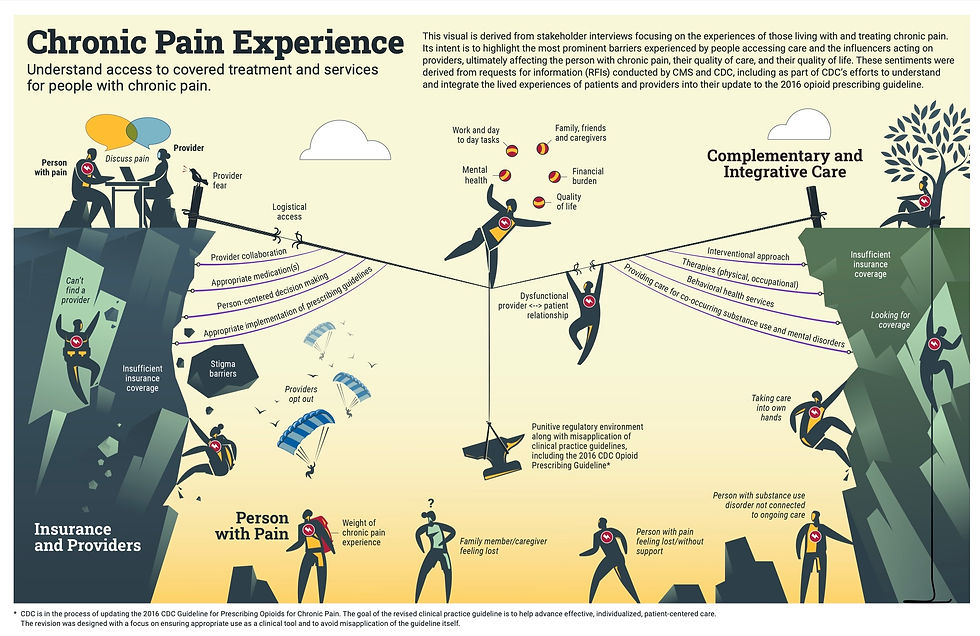Have you heard of Justin Schmidt’s Sting Pain Index? He’s an entomologist who also happens to catalogue sting pain from insects around the world. He uses some great descriptors too: A bullet ant sting is described as “like fire-walking over flaming charcoal with a 3-inch nail embedded in your heel.”

These pain ratings are hilarious but they also illustrate the issue with pain scales. They’re subjective and dependent on individual experience, pain tolerance, and, one’s flair for the dramatic. The descriptions are memorable, but they don’t tell you how each sting might actually affect your day. Can you type on a computer after a tarantula hawk wasp sting? Can you walk? How is your sleep? How are you managing? When you see the image below of “The Chronic Pain Experience” you realise how little can be communicated using a number.

Numbers are used though, because there is no definitive test to measure pain.
The scale that you are probably familiar with is the visual analogue scale (VAS). It asks people to rate their pain intensity with zero as no pain and 10 as the worst pain imaginable. Or, in this case - how does it compare to being mauled by a bear?

Or, this one as designed by someone living with a chronic illness, that illustrates that my zero (no pain) is their negative 3. My 10 (severe pain) is their 7.

For my thesis I used a more detailed measurement, I used the McGill Pain Questionnaire (MPQ) which lists 78 words associated with pain. It takes about half an hour and you’re asked to choose the words that best describe your pain such as stabbing, intense, itchy, tender or tight.

It is still not the solution. The problem with using a scoring system to evaluate your pain is that it doesn’t take into account pain tolerance and a person’s every day experience of pain. It also doesn’t account for pain history. After a person has had a debilitating pain flare their response to even a twinge in that same area will be strong. Their response to treatment will depend on how it worked in the past. They will very likely be experiencing the pain, stress, fear cycle.

It doesn’t allow for the facets of the persistent pain experience. It doesn’t acknowledge the physical, psychological, spiritual and social ramifications of the pain experience. A number cannot reflect the level of anxiety, anger, grief, or helplessness a person is feeling.

Finally, a pain assessment is just a snapshot of how you are feeling at this point in your pain cycle. Pain fluctuates throughout the day, the week and even the season. Some days you’ll move mountains other days you’ll move from the bed to the couch. Pain also changes with activity, gentle walking can help back pain and sitting for long periods will make it worse.

So if pain scales aren’t perfect what should you use instead?
This is a functional scale. It asks you to list five important activities that you would like to be able to do or that are necessary for your functioning. They are activities impacted by your pain. They measure what you can do despite the pain. Can you dress yourself? Can you lift your child? These are the things that actually matter when managing pain and recovery, and they’re much easier to understand and communicate.

Once you have listed your five activities, you then set goals. If you want to be able to walk to your local shops and back, you work your way up to this. To start with you might need to get out of bed every day. You stick with this for a week. Then you might need to sit on your front or back step/ porch every day. Incrementally you work your way up to engaging fully with life again. You do this despite the pain. Instead of letting pain win and focussing on your numbers, you appreciate that life is more than data. You engage what is important to you. You put yourself, not your pain at the centre of your life.

So, if you are stung by a yellow paper wasp feel free to turn to a pain scale, if you are living with pain and would like to track your progress. Then I encourage you to focus on your functional improvements, not your pain scores.
Even when they are as artistic as this one 👇🏽



Comments